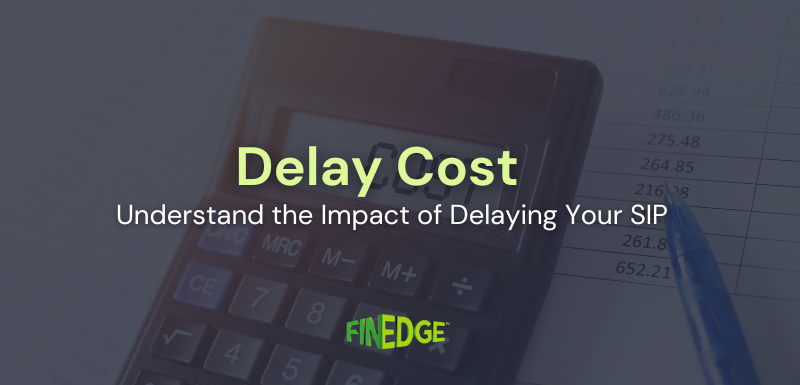Investing Insights
Cost of Delay in Investment: Why Starting Early Matters
Many investors assume that postponing their SIP temporarily has a minor impact. In reality, the true loss comes from the compounding opportunity that disappears with every missed month. A consistent approach is far more powerful than trying to compensate later by investing larger amounts.
How to Cancel Your SIP Online: A Step-by-Step Guide
Stopping a Systematic Investment Plan (SIP) is simple but following the right steps ensures your cancellation request is processed smoothly without delays.
How to Build a ₹1 Crore Portfolio: A Practical Guide for Indian Investors
Reaching ₹1 crore isn’t about luck or timing, it’s about discipline, consistency, and the patience to let compounding work in your favor.
Are Mutual Fund SIP Investments Low Risk?
Many first-time investors believe that SIPs are a low-risk way to enter the market. But is that really true? The idea that SIPs offer guaranteed safety can be misleading, especially if the underlying fund is equity-oriented. This blog breaks down the real risk profile of SIPs and helps you understand how they work in volatile markets.
What are the Different Types of SIPs? How to Use Step-Up SIP to Reach Your Financial Goals Faster
SIPs (Systematic Investment Plans) are a cornerstone of goal-based investing in India. But did you know that there’s more than one type of SIP? From the simplicity of Regular SIPs to the adaptability of Flexible SIPs, and the acceleration potential of Step-Up SIPs, there’s a strategy for every kind of investor. In this blog, we’ll explain the different types of SIPs and show you how a Step-Up SIP could help you reach your financial goals faster.
What Is the Real SIP Return After 10 Years? The Truth Long-Term Investors Should Know
In recent years, SIPs (Systematic Investment Plans) have gained immense popularity among Indian investors seeking long-term wealth creation. But how have SIPs actually performed over a decade? If you're wondering what the average SIP return in 10 years really looks like, and whether it's enough to meet your financial goals, this blog breaks down the numbers and what they mean for your future.
Common SIP Mistakes Investors Should Avoid for Long-Term Success
Systematic Investment Plans (SIPs) have become a go-to strategy for long-term investing, especially for Indian investors. But while SIPs are simple to start, avoiding common mistakes is crucial for achieving meaningful outcomes. From skipping instalments to choosing the wrong options, this blog walks you through the key SIP mistakes to avoid, and how to make the most of your investments.
How Falling Markets Can Benefit Your SIP Plan
Falling markets often make investors uneasy, but if you're investing through a Systematic Investment Plan (SIP), downturns could actually work in your favour. SIPs help you average your purchase cost, stay invested without trying to time the market, and benefit from compounding over time. This blog explores how your SIP can turn market volatility into long-term wealth-building opportunities.
Daily, Weekly, or Monthly SIP: Which One Should You Choose?
While SIPs are the preferred way for most Indian investors to invest in mutual funds, one question often comes up: should you invest daily, weekly, or monthly? Many assume more frequent investing brings higher returns, but does the data support that belief? In this article, we’ll compare SIP frequencies based on long-term market data and help you choose what’s best for your goals and convenience.
Benefits of Investing in SIPs for Goals: How SIPs Align with Your Financial Milestones
For Indian investors focused on goal-based investing, SIPs offer one of the most effective routes to financial success. Whether you’re planning for your child’s education, your dream home, or a comfortable retirement, SIPs help you stay consistent and resilient through market ups and downs. This blog explores how SIPs support specific financial goals through disciplined investing, and why they’re a strong fit for long-term wealth creation.
How to Start SIP Investment: A Beginner-Friendly Guide for Long-Term Growth
If you're wondering how to start SIP investment, you're not alone. SIPs, or Systematic Investment Plans, have become one of the most popular tools for long-term wealth creation in India. They’re simple, disciplined, and powerful - especially for those earning monthly incomes and looking to grow their savings through mutual funds. This guide explains how SIPs work, how to get started (both online and offline), and why they are trusted by millions of investors for goal-based financial planning.
How SIP and Step-Up SIP Calculators Help You Plan Better
Starting a SIP is easy. But knowing how much to invest, for how long, and whether you should increase it annually? That’s where most investors struggle. This is where a SIP calculator, and even better, a step-up SIP calculator, can guide you. These tools aren’t just digital widgets; they bring structure and clarity to your financial journey, ensuring your SIPs are aligned to real-world goals.
Latest Posts
The Portfolio Health Check: 5 Signals Your Investments Need Attention
Jan 05, 2026
From Coffee to Crorepati: Small Lifestyle Tweaks Gen Z Can Make to Start Investing Early
Jan 02, 2026
Lessons From the World’s Best Investors to Carry Into the New Year
Dec 26, 2025
Why Consolidating All Your Investments on One Platform Makes Sense
Dec 24, 2025
Why Comparing Investment Returns Can Be Misleading
Dec 22, 2025
The Importance of your Child’s Education Goal
Feb 28, 2024
Why Retirement Planning is Important
Nov 08, 2023
Oct 31, 2023
Investing Behaviour and the investing roller coaster
Oct 12, 2023
Investing Stories

.png)

.jpg)

.jpg)


_(42).jpg)
.jpg)

.jpg)





.jpg)
_(1)1.jpg)
.jpg)
.jpg)
.jpg)